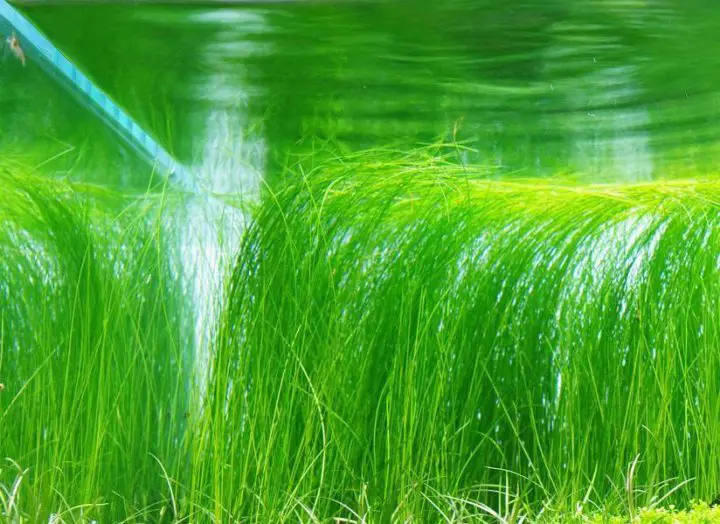Eleocharis vivipara is an aquatic plant that is often used to decorate aquariums. It occurs naturally in the wetlands of North and South America, Asia, and Australia. There are so many varieties of aquarium plants.

Table of Contents
Eleocharis Vivipara Description
Eleocharis vivipara is characterized by its fast growth and the ability to form dense thickets, therefore it is often planted in the back of the aquarium. The height of the bush rarely exceeds 35-40 cm. The leaves are elongated, acicular, dark green in color. At their tips, daughter plants are formed, which later begin to put out aerial roots, spoiling the appearance of thickets. Rhizome is fibrous, quickly grows into the soil.
KEEPING IN THE AQUARIUM
Viviparous Eleocharis does not require special care and the creation of specific conditions. This plant is more suitable for keeping in small to medium-sized aquariums. In large containers, Eleocharis may lack light. The soil should be sandy with the inclusion of small pebbles. The minimum soil layer thickness is 4 cm.
The recommended water temperature is + 24 … + 25 ° C, but the plant can withstand a short-term drop to + 18 ° C and an increase to + 28 ° C. The hardness of the water is 1-6 dH, and the acidity is 5.3-7.4 pH. The required degree of illumination is 70-100 lm / l.
To accelerate growth, Eleocharis is fed with liquid micronutrient fertilizers and CO2. The aquarium should be equipped with a filtration system to reduce the risk of nitrite and ammonia build-up in the water.
It is advisable to regularly perform aeration. It is necessary to periodically prune the plant, since it grows rapidly, becoming shapeless.
Another way to control the growth of Eleocharis is to colonize herbivores in the aquarium:
- snails;
- ototsinklus;
- Siamese algae eaters;
- Amano shrimp, etc.
For eleocharis, an increase in the number of unicellular algae is dangerous, since this leads to a decrease in the transparency of the water and the death of plant leaves. It is periodically required to trim and comb the plant to remove unnecessary young shoots.
REPRODUCTION
Daughter plants begin to form on leaves larger than 10 cm. You need to wait for the sprouts to sprout. This will increase the chances of their survival in the ground. When young daughter bushes are formed, they must be carefully separated from the mother leaf and planted in the ground. You can place the bushes close to each other so that the thickets are dense.
Eleocharis acicularis
Eleocharis acicular produces many needle-like leaves. The plant forms a dense bush, which can reach a height of 40 cm, but in insufficient light, it grows up to 10-15 cm. It grows more slowly than Eleocharis viviparous.
This type of Eleocharis is suitable for a low-water aquarium. Keeping containers at a high level leads to a decrease in the intensity of growth. It can be used to decorate both the front and back of the aquarium.
Eleocharis tolerates haircuts well. No shoots are formed on the tops of the leaves, therefore, the needle squirrel does not require frequent combing.
However, to maintain the decorative appearance of Eleocharis, it is necessary to cut it once a month. The plant is thermophilic, so the water temperature should be + 23 … + 26 ° C. In winter, it can survive a drop in temperature to + 12 … + 15 ° C.
This type of eleocharis can withstand water hardness up to 15 dH, as well as acidity up to 7.5 pH. Sitnyags are planted on sandy-stony soil, the thickness of which is 4-6 cm. The rhizome grows rapidly and penetrates into the deep layers of the soil mixture. Sitnyag reproduces by soil layers.
To accelerate growth, it is recommended to feed with liquid mineral fertilizers once a month. Plaque build-up on the leaves can kill the plant. To prevent this from happening, it is necessary to filter the soil and replace the water in the aquarium.
Eleocharis parvula
Eleocharis parvula grows in the form of a bush, throwing out many thin sheets of pale green color. Forms dense, low-growing thickets resembling a lawn.
This type of eleocharis does not tolerate the presence of unicellular algae in the aquarium, which, settling on the leaves, lead to their death. The water temperature should be + 22… + 27 ° C. The recommended parameters of hardness are 7-8 dH, and acidity is 5-8 pH.
In order for the bush to grow quickly, additional lighting is required. In addition, it is important to ensure high-quality water filtration, since an increase in the level of nitrite and ammonia can lead to the death of eleocharis.
Eleocharis acicularis ‘mini’
Eleocharis mini belongs to the dwarf varieties of the aquarium plant. It produces a large number of leaves and forms a bush, but its height does not exceed 5-7 cm.
Eleocharis mini is suitable for decorating the front edge of the aquarium, creating a depth effect. Under favorable conditions, it grows rapidly, filling the bottom surface. Prefers sandy soil, the thickness of which should be at least 5-7 cm.
The rhizome is developed, lobular. The plant is planted in bunches at a distance of 2 cm from each other. Eleocharis mini tolerates a water temperature of + 15 … + 28 ° C. The recommended hardness is 4-15 dH, and the acidity is 5.5-8 pH. To accelerate growth, it is advisable to fertilize with CO2 at the rate of 5-10 mg / l once a month. Additionally, mineral fertilizers are applied.